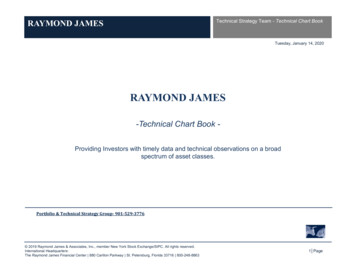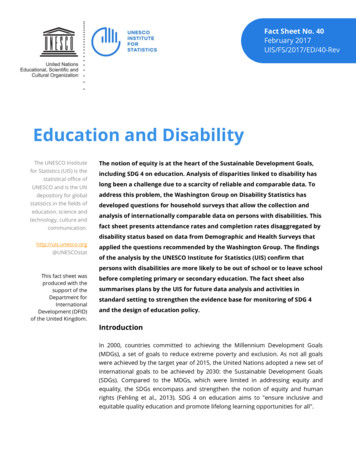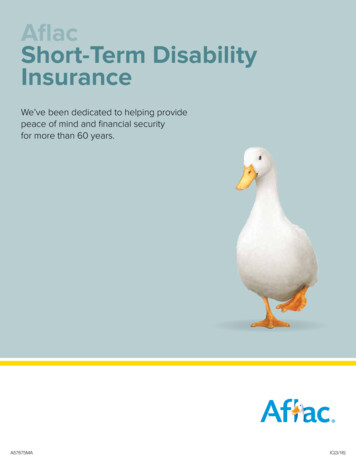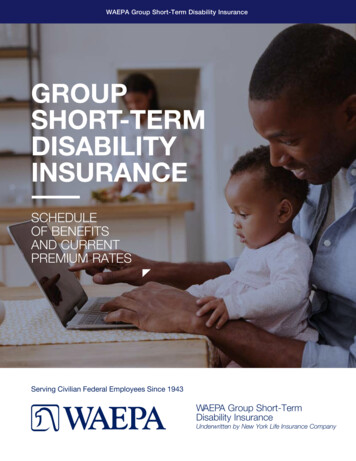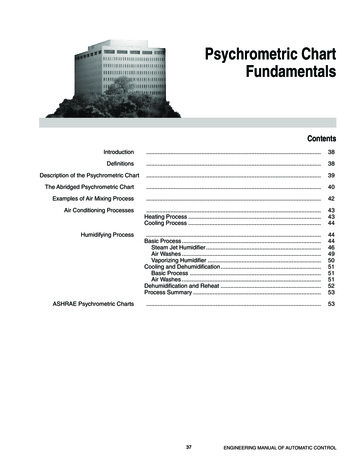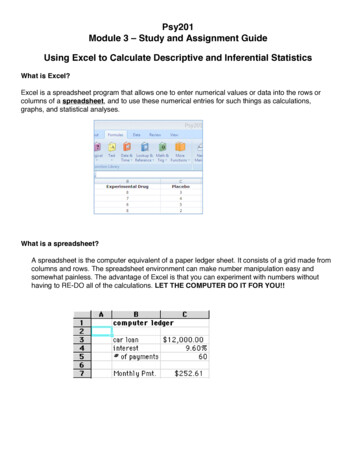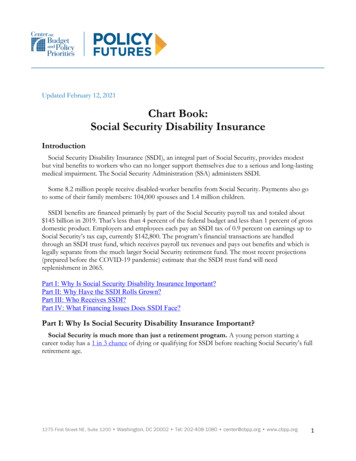
Transcription
Updated February 12, 2021Chart Book:Social Security Disability InsuranceIntroductionSocial Security Disability Insurance (SSDI), an integral part of Social Security, provides modestbut vital benefits to workers who can no longer support themselves due to a serious and long-lastingmedical impairment. The Social Security Administration (SSA) administers SSDI.Some 8.2 million people receive disabled-worker benefits from Social Security. Payments also goto some of their family members: 104,000 spouses and 1.4 million children.SSDI benefits are financed primarily by part of the Social Security payroll tax and totaled about 145 billion in 2019. That’s less than 4 percent of the federal budget and less than 1 percent of grossdomestic product. Employers and employees each pay an SSDI tax of 0.9 percent on earnings up toSocial Security’s tax cap, currently 142,800. The program’s financial transactions are handledthrough an SSDI trust fund, which receives payroll tax revenues and pays out benefits and which islegally separate from the much larger Social Security retirement fund. The most recent projections(prepared before the COVID-19 pandemic) estimate that the SSDI trust fund will needreplenishment in 2065.Part I: Why Is Social Security Disability Insurance Important?Part II: Why Have the SSDI Rolls Grown?Part III: Who Receives SSDI?Part IV: What Financing Issues Does SSDI Face?Part I: Why Is Social Security Disability Insurance Important?Social Security is much more than just a retirement program. A young person starting acareer today has a 1 in 3 chance of dying or qualifying for SSDI before reaching Social Security’s fullretirement age.1275 First Street NE, Suite 1200 Washington, DC 20002 Tel: 202-408-1080 center@cbpp.org www.cbpp.org1
SSDI is an earned benefit that offers vital protection to millions of workers. Through theirpayroll tax contributions, almost 156 million workers have earned SSDI protection in case ofa severe, long-lasting medical impairment. About 8.2 million of them receive disabled-workerbenefits from SSDI.1275 First Street NE, Suite 1200 Washington, DC 20002 Tel: 202-408-1080 center@cbpp.org www.cbpp.org2
The risk of disability rises with age. People are twice as likely to collect SSDI at age 50 as at 40— and twice as likely at age 60 as at 50.1275 First Street NE, Suite 1200 Washington, DC 20002 Tel: 202-408-1080 center@cbpp.org www.cbpp.org3
Disability can have devastating economic consequences. Not only can disability happen toanyone — especially with advancing age — but it greatly harms people’s economic circumstances.The worker’s earnings, total family income, and purchases of essentials like food and housing all fallsignificantly.Part II: Why Did SSDI Enrollment Grow?The number of disability beneficiaries grew substantially from the 1990s through the early2010s but has since declined. The bulk of the increase stemmed from four big demographicfactors: Population growth Aging of the baby boom Growth in women’s labor force participation Rise in Social Security’s full retirement age from 65 to 66When adjusted for these factors, the share of insured workers receiving SSDI benefits grewonly modestly and has declined in more recent years, as the baby boom generation has aged into itspeak retirement years. (Disabled workers are converted to retired workers at the full retirement age— currently 66 and scheduled to rise to 67 — and many baby boomers have reached thatmilestone.)1275 First Street NE, Suite 1200 Washington, DC 20002 Tel: 202-408-1080 center@cbpp.org www.cbpp.org4
Not only has the population grown, but the aging of the baby boomers caused atemporary spike in SSDI eligibility, which is now subsiding. Population growth, aging, andwomen’s labor-force participation boosted the eligibility pool for SSDI. When SSDI eligibilitypeaked, most baby boomers — people born between 1946 and 1964 — were in their 50s and 60s,years of peak risk for disability. (And female boomers, unlike earlier generations of women, areoverwhelmingly likely to have worked enough to be insured for SSDI.) Now the baby boomers haveaged into or are approaching their retirement years, and SSDI enrollment has declined.1275 First Street NE, Suite 1200 Washington, DC 20002 Tel: 202-408-1080 center@cbpp.org www.cbpp.org5
Women SSDI beneficiaries have caught up with men. In SSDI’s early years, malebeneficiaries vastly outnumbered women. As late as 1990, that ratio was almost 2 to 1. Now, withthe growth of women’s participation in the labor force, nearly equal numbers of men and womencollect SSDI.1275 First Street NE, Suite 1200 Washington, DC 20002 Tel: 202-408-1080 center@cbpp.org www.cbpp.org6
Unlike previous recessions, which swelled SSDI applications and — to a lesser extent —awards, the COVID-induced recession has led to lower applications and awards. Economicdownturns generally lead some workers to seek SSDI benefits, but a sour economy boostsapplications by much more than actual awards because approval rates fall. The COVID-inducedrecession that began in 2020 has departed from these trends; after SSA’s field offices closed, SSDIapplications declined significantly even as economic hardship and health problems increased. Evenwhen a recession causes SSDI applications and awards to increase, it generally has amuch larger effect on SSDI’s income, which falls when workers contribute less to Social Securitybecause their earnings and employment have dropped.SSDI growth has leveled off. In fact, since 2014 the number of beneficiaries has fallen asdemographic and economic pressures on the program have eased. Social Security’s trustees projectthat the share of Americans receiving SSDI will remain stable in the coming decades.1275 First Street NE, Suite 1200 Washington, DC 20002 Tel: 202-408-1080 center@cbpp.org www.cbpp.org7
Part III: Who Receives SSDI?Eligibility criteria are strict, and most SSDI applicants are rejected. Applicants for SSDIbenefits must be — Insured for disability benefits (essentially, they must have worked for at least one-fourth oftheir adult life and five of the last ten years). Suffering from a severe, medically determinable physical or mental impairment that isexpected to last 12 months or result in death, based on clinical findings from acceptablemedical sources. Unable to perform “substantial gainful activity” (any job that generates earnings of 1,310 permonth for most people, 2,190 for blind people) anywhere in the national economy —regardless of whether such work exists in the area where the applicant lives, whether a specificjob vacancy exists, or whether he or she would be hired.Lack of education and low skills are considered for older, severely impaired applicants who can’trealistically change careers — but not for younger applicants.There is a five-month waiting period for SSDI, but Supplemental Security Income may beavailable during that period for poor beneficiaries with little or no income and assets.SSA denies applicants who are technically disqualified (chiefly because they haven’t worked longenough) and sends the rest to state disability determination services (DDS) for medical evaluation.Applicants denied at that stage may ask for a reconsideration by the same state agency, and thenappeal to an administrative law judge (ALJ) at SSA. Roughly half of people who get an initial denialpursue an appeal.1275 First Street NE, Suite 1200 Washington, DC 20002 Tel: 202-408-1080 center@cbpp.org www.cbpp.org8
Ultimately — if we follow a cohort of applicants to the end of their application and appealprocess — fewer than 4 in 10 are awarded benefits. Among applicants who meet the program’stechnical requirements, slightly more than half are found medically eligible for SSDI.SSA monitors disability decisions at all stages of the process. SSA conducts ongoing qualityreviews at all stages of the application and appeal process. Many reviews occur before any benefitsare paid, thus reducing errors.Allowance rates at the initial application and reconsideration stages have been relatively stableover the last two decades. However, allowance rates dropped noticeably at the ALJ stage from 2010to 2014, as SSA increased oversight of hearings. (These allowance rates reflect decisions made in aparticular year, on applications filed in different years, so they aren’t directly comparable to thosederived from following a cohort of applicants through their entire process.)Allowance rates remain higher at the ALJ stage than at the initial stage, however. This is partlybecause ALJs often see claimants whose condition has deteriorated in the year or so since theirapplication was turned down and whose application is better documented (typically with the help ofan attorney) than at the DDS stage.1275 First Street NE, Suite 1200 Washington, DC 20002 Tel: 202-408-1080 center@cbpp.org www.cbpp.org9
SSDI beneficiaries are mostly older and have severe physical or mental impairments. Thetypical SSDI beneficiary is in his or her late 50s — 75 percent are over age 50, and nearly 35 percentare 60 or older — and suffers from a severe mental, musculoskeletal, or other debilitatingimpairment. Physical disorders dominate among beneficiaries age 50 or older. Mental disorders —including intellectual disability (formerly called mental retardation), mood disorders such as bipolardisease and severe depression, organic mental disorders associated with brain disease or damage,psychotic disorders such as schizophrenia, and other mental impairments — account for half ofbeneficiaries under age 50.1275 First Street NE, Suite 1200 Washington, DC 20002 Tel: 202-408-1080 center@cbpp.org www.cbpp.org10
SSDI beneficiaries experience high death rates. Mortality among older SSDI beneficiaries —who dominate the program’s enrollment — is three to six times the average for their age group.Many die within a few years of qualifying for SSDI.1275 First Street NE, Suite 1200 Washington, DC 20002 Tel: 202-408-1080 center@cbpp.org www.cbpp.org11
People with limited education are much likelier to collect SSDI. Those withlimited education and skills generally have to do physical work and can’t switch to somethingsedentary. Thus, people without a college degree are far more likely to collect SSDI.1275 First Street NE, Suite 1200 Washington, DC 20002 Tel: 202-408-1080 center@cbpp.org www.cbpp.org12
Disability beneficiaries exhibit a distinct geographic pattern. States with low high-schoolcompletion rates, more older residents, few immigrants, and a blue-collar industry mix tend tohave more SSDI beneficiaries. Isolated pockets with unusually high rates of receipt are extremeoutliers.1275 First Street NE, Suite 1200 Washington, DC 20002 Tel: 202-408-1080 center@cbpp.org www.cbpp.org13
Many SSDI beneficiaries are poor. Poverty rates are about twice as high for SSDI beneficiariesas for others — even including their benefits. Overall, about one-fifth of all disabled-worker familiesare poor; without SSDI, nearly half would be.1275 First Street NE, Suite 1200 Washington, DC 20002 Tel: 202-408-1080 center@cbpp.org www.cbpp.org14
SSDI beneficiaries have limited work capacity. SSDI applicants typically suffer a sharp dropin earnings before turning to the program. The most severely impaired — who are awarded benefits— seldom work afterward. Even rejected applicants fare poorly in the labor market afterward, moreevidence that the program’s eligibility criteria are strict.1275 First Street NE, Suite 1200 Washington, DC 20002 Tel: 202-408-1080 center@cbpp.org www.cbpp.org15
Although SSDI allows beneficiaries to supplement their benefits through work, few areable to do so. Program rules allow and encourage SSDI beneficiaries to earn up to the “substantialgainful activity” level ( 1,319 a month in 2021, about 40 percent of median earnings for a highschool graduate with no college). Beneficiaries may earn unlimited amounts for a nine-month trialwork period and a subsequent three-month grace period before benefits are suspended. Even then,they may return to SSDI if their earnings fall. And former beneficiaries who’ve returned to workmay keep their Medicare (which is available to SSDI beneficiaries after two years) for seven and ahalf years after their cash benefits stop.But most SSDI beneficiaries can’t work. Of beneficiaries who were tracked for ten years afterqualifying, only about 28 percent did any paid work, 7 percent had benefits suspended for at leastone month because of work, and 4 percent had benefits terminated because of sustained work.It’s useful, too, to compare SSDI beneficiaries with rejected applicants and with people who’venever applied for benefits. One careful study found that only one-fifth of beneficiaries aged 45 to 64— and only about half of rejected applicants — had any earnings two years after application, andeven fewer had significant earnings. In contrast, healthy workers of the same age (who didn’t seekSSDI benefits) were likely to work and had substantial earnings.1275 First Street NE, Suite 1200 Washington, DC 20002 Tel: 202-408-1080 center@cbpp.org www.cbpp.org16
Part IV: What Financing Issues Does SSDI Face?SSDI costs have leveled off, but the program faces a long-run funding gap. SSDI costs havestabilized as the baby boomers move from their peak disability-prone years to their peak retirementyears. But SSDI’s costs will still exceed its revenues. Over the next 75 years, its shortfall is projectedto be about 6 percent of the program’s costs or income. (The latest annual report from the SocialSecurity trustees does not reflect the effects of the COVID-19 pandemic and the resulting recessionon the programs’ trust funds, and so doesn’t provide an up-to-date picture of Social Security’sfinancial status.)1275 First Street NE, Suite 1200 Washington, DC 20002 Tel: 202-408-1080 center@cbpp.org www.cbpp.org17
SSDI has financial challenges but doesn’t face “bankruptcy.” The payroll taxes that workerscontribute out of every paycheck fund most of SSDI’s costs. In addition, SSDI has built up trustfund reserves, which Social Security’s trustees estimate will last until 2065. At that point, taxrevenues will be enough to pay for 92 percent of benefits — even if policymakers do nothing tostrengthen Social Security’s financing (though they always have in the past).Though the SSDI trust fund has enough funding for more than three decades, policymakers mustaddress overall Social Security financing before then. Overall, Social Security can pay full benefits for16 more years, the trustees’ annual report shows, but then faces a significant, though manageable,funding shortfall. Policymakers should address Social Security’s long-term shortfall primarily byincreasing Social Security’s tax revenues. Social Security will necessarily require an increasing share ofour nation’s resources as the population ages, and polls show a widespread willingness to pay moreto strengthen the program.1275 First Street NE, Suite 1200 Washington, DC 20002 Tel: 202-408-1080 center@cbpp.org www.cbpp.org18
SSDI benefits are modest. The average disabled-worker benefit is about 1,236 a month, and 90percent of beneficiaries get less than 2,000 a month.Most beneficiaries — especially unmarried ones — rely on SSDI for most of their income. SSDIbenefits replace about half of past earnings for a median beneficiary.1275 First Street NE, Suite 1200 Washington, DC 20002 Tel: 202-408-1080 center@cbpp.org www.cbpp.org19
Most other advanced countries spend more than the United States on disabilitybenefits. U.S. eligibility rules are strict, and benefit levels are modest. The Organisation forEconomic Co-operation and Development (OECD) reports that the United States has some of themost stringent eligibility criteria for disability benefits among advanced economies. OECDstatistics confirm that, as a corollary, the United States spends less on disability benefits (as a shareof the economy) than most other advanced countries.1275 First Street NE, Suite 1200 Washington, DC 20002 Tel: 202-408-1080 center@cbpp.org www.cbpp.org20
1275 First Street NE, Suite 1200 Washington, DC 20002 Tel: 202-408-1080 center@cbpp.org www.cbpp.org21
Social Security’s administrative funding is inadequate. The Social Security Administration’sadministrative funding (which, unlike Social Security benefits, is subject to annual appropriation) hasdeclined in real terms since 2010, even as enrollment has climbed. That has impaired customerservice by increasing wait times at field offices and on the phone. Staff cutbacks have also led togrowing delays in processing applications or changing benefits when a beneficiary’s circumstanceschange.Another consequence of the cuts is that about 400,000 people await a final decision on theirapplication for SSDI — after paying into Social Security their entire career — or their applicationfor disability benefits from the Supplemental Security Income program. They wait an average ofabout 300 days for decisions on their appeals.Since the pandemic struck in early 2020, field office closures due to COVID-19 have added to theproblems caused by inadequate SSA funding.1275 First Street NE, Suite 1200 Washington, DC 20002 Tel: 202-408-1080 center@cbpp.org www.cbpp.org22
Feb 12, 2021


